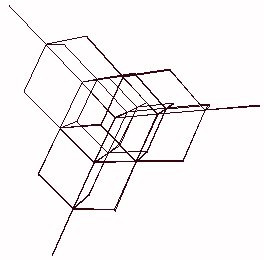Pascal's Tetrahedron
& T-space [1]
by Kirby Urner
Feb 7 1997
You drop a bead through the apex of a tetrahedron, it falls straight down to the center, where it encounters three branching pipes, each to a base vertex. Each vertex is then the apex of yet another tetrahedron, and so on down. This is Pascal's Tetrahedron (Brian Hutchings shares the marquee as per postings to Synergetics-L).
This is also the fanning out of T-paths, where returning up against gravity is not an option. (1,0,0,0) (0,1,0,0) and (0,0,1,0) are your only options (0,0,0,1) being defined as upward in this picture.
 |
You do fall down however, so the (0,0,0,1) path gets used, in reverse.
Dare we invite (0,0,0,-1) into the picture? This is equivalently (1,1,1,0).
So after each roll down a slanted pipe, we'll need a straight-down fall
along (1,1,1,0) to complete the picture. We should start with such a fall
as well, down to the first decision point.
Note that in constructing this apparatus from T-paths, we are imposing a different regime than the v-rays by themselves. The T-path matrix as described by v-rays alone (no other restrictions) is one of face-bonded hexahedra of volume 1.5, four around a common vertex giving a rhombic dodecahedron of volume 6.
| As IVM centers are likewise
at the centers of rhombic dodecahedra (the voronoi cells for IVM spheres),
T-space is one which joins IVM sphere-centers to 4 of the 8 rhombic
dodeca vertices where three facets meet -- four facets meet at the
other six voids (oriented in XYZ directions from one another). T'-space
connects IVM sphere-centers to the alternate 4 of the 8 3-facet vertices.
T-space also provides the rhombic dodeca network interconnecting these voids, thereby outlining all the face-bonding between rhombic dodecahedral cells (these are also the equators of couplers, irregular spacefilling octahedra with IVM-center terminals). |
|
